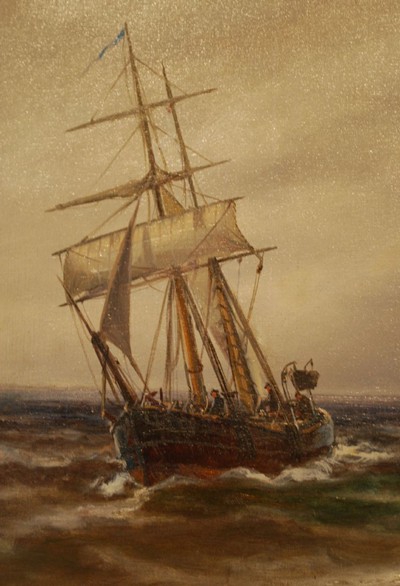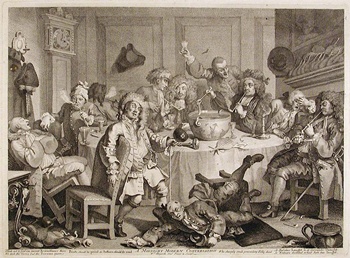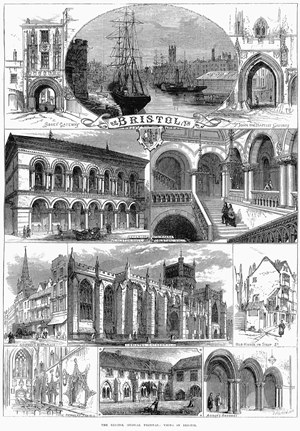| The 1732 Voyage on the Pink
"John & William" - Voyager's Epilogue
|















|
|
|
The Pink "John and William"
and Captain Tymperton
in
The 1732 Voyager's Epilogue
By Rick Bushong
April 2014
|
|
|
|
|
|
The "John and William" docked, but the 169 passengers and their children were not immediately free to go. They were required to stay on the ship until Captain Tymperton released them. The men, all being foreign-born nationals, were taken to City Hall to swear allegiance to the British Crown and sign their names or make their mark and were returned to the ship. Then when they had paid for their passage and any other charges that accumulated on the voyage, the passengers were free to go. The rest remained virtual prisoners of the ship and Capt. Tymperton.1; 2 Likely
family, friends, and concerned townspeople
continued to supply food, water, and medicine to the boat,
as they did for the brigantine "Pennsylvania Merchant" in 1733.2 It was worse for those who could not pay their full bill with the shipping company. They had to indenture
themselves to someone who could pay their bill. In return, they would agree to work to satisfy that debt. However, those
looking for servants and able workers would have found it difficult to judge between the malnourished and sickly remaining passengers. Because of this, the sickest had to stay the longest on board the ship.1 Eventually, except for a few delinquent accounts the rest became indentured. Of those, some were in servitude for as little as two years, but others, for example, Henrich Gek (Keck) it was three or four years.40
|
|
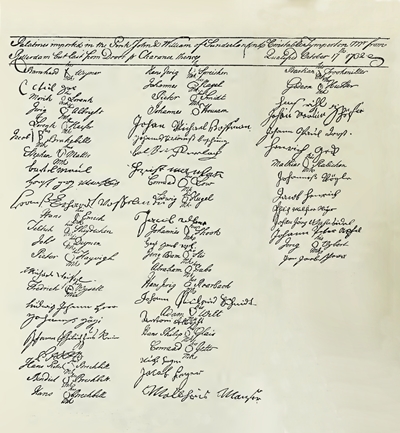
The Pink John and William's" Oath of Allegiance, October 17, 1732. Nicholas' signature is located in the center, sixth from the top and below fellow passenger, Johann Michel Hoffman's similar signature.
|
The Oath
"I do solemnly, sincerely and truly acknowledge,
profess, testify and declare that King George the
Second is the lawful and rightful King of the Realm of
Great Britain and all others his Dominions and
Countries. And do declare that I do believe the Person
pretending to be Prince of Wales during the Life of
late King James hath not any right or title whatsoever
to the Crown of the Realm of Great Britain. I will of
my best endeavors and make known to King George the
Second and his successors all treasons and traitorous
conspiracies which I shall know to be made against
him. And I do make this Recognition, Acknowledgment,
Renunciation and Promise heartily, willingly and
trule."
|
The Men:
1 Hans Earhart Vosselman
2 Pieter Harbyn, sick
3 Hans Emich
4 Helflick Shedeicher
5 Laurence Rosier, sick
6 Johannes Deynen
7 Stephen Matts
8 Fridrich Cooler, sick
9 Pieter Huvigh
10 Michael Wysel
11 Fridrich Wisel
12 Laurence Keiyfer
13 Philip Melchionar, sick
14 Ludwick Melchionar
15 Johannes Yege
16 Bartel Moll
17 Philip Reynhart
18 Hans Pieter Britbill
19 Benedick Britbill
20 Jacob Britbill
21 Hans Britbill
22 Johan Vintenhelver, sick
23 Hand Jerick Spreaker
24 Johannes Nagel
25 Pieter Smidt
26 Johannes Hunsam
27 Johan Michael Hufman
28 Nicholas Paushon
29 Bernard Weymer
30 Balsar Gerloch
31 Christian Low
32 Conraed Low
33 Ludwick Hugel
34 Jacob Weyber
35 Morris Lorrence
36 Johannes Shook
37 Hans Jacob Reyl
38 Jerig Adam Stis
39 Philip Jacob Proops, sick
40 Michael Miller, sick
41 Abraham Dubo
42 Philip Dubo, sick
43 Hans Jerick Roerbach
44 Johan Michael Smit
45 Adam Wilt
46 Gerich Albrecht
47 Antonius Albrecht
48 Hans Woolf Doopel, sick
49 Joseph Houbly, sick
50 Hans Philip Glais
51 Conrad Gets
52 Nicholaus Kooger
53 Jacob Kooger
54 Mathias Menser
55 Bastian Trookmiller
56 Giedon Huffer
57 Hans Reyl
58 Johan Martin Shoppfield
59 Casperrias Vielard
60 Hans Jerich Martin
61 Paul Derst
62 Hendrick Gek
63 Mathias Rubichon
64 Johannes Vigelie
65 Jacob Hendrick
66 Philip Melchior Meyer
67 Johan Jerich Vansettel
68 Pieter Apfel
69 Jerich Vybert
70 Jacob Sheare
71 Michael Proops, sick
Women & Children
72 Elisabetha Margareta {Vosselman}
73 Margaret Harbyn
74 Dorothy Emich
75 Nicholas Emich
76 Johannes Emich
77 Jacob Emich
78 Marilas Shyndech
79 Cathrina Matts
80 Dorothy Rosar
81 Dorothy Kooger
82 Elisabeth Kooger
83 Barbara Hyvigh
84 Susanna Wysel
85 Ablonia Wysel
86 Barbara Wysel
87 Barbara Kuyser
88 Maris Savina [Kuyser]
89 Johan David [Kuyser]
90 Luodwick Melchionar
91 Anna Drogo
92 Maria Katrina
93 Paulina Yege
94 Katrina Moll
95 Maria Britbill
96 Anna Britbill
97 Maria Helferen
98 Christophel Helferen
99 Cathrina Spreakering
100 Maria Nagelin
101 Cathrena Shabel
102 Maria Smit
103 Maria Hausman
104 Eva Hausman
105 Magdalena Panchson
106 Andreas Panchson
107 Hendrich Panchson
108 Maria Panchson
109 Eve Panchson
110 Barbara Veymert
111 Johannes Veymert
112 Maria Gerloch
113 Anna Gluf Lowein
114 Philip Lowein
115 Christian Lowein
116 Barbara Lowein
117 Margaret Lowein
118 Anna Hugel Reyn
119 Christina Bever
120 Jacob Bever
121 Dorothy Bever
122 Barbara Lorrence
123 Maria Shooken
124 Hans Shooken
125 Maria Shooken
126 Cathrina Shooken
127 Jacob Lorrence
128 Eve Reylen
129 Jerick Reylen
130 Jacob Vry
131 Catharin Spis
132 Susanna Spis
133 Michael Proops
134 Felder Proops
135 Cathrina Miller
136 Cathrina Miller
137 Philiphbena Miller
138 Caspar Miller
139 Hans Miller
140 Michael Miller
141 Cathrina Proops
142 Anna Dubo
143 Anna Smit
144 Barbara Albrecht
145 Peter Albrecht
146 Hans Albrecht
147 Susan Husselich
148 Bernard Husselich
149 Michael Husselich
150 Maria Glassen
151 Maria Getson
152 Cathrina Trookmiller
153 Cathrina Reyl
154 Michael Reyl
155 Maria Reyl
156 Anna Martin
157 Maria Martin
158 Michael Martin
159 Magdalena Vielard
160 Charl. De Meyeren
161 Cathrina Vansettel
162 Johan Revenooch
163 Apalonia Apel
164 Sophia Rynhart
165 Anna Kootson
166 Anna Wyberton
167 Gertruy Smiden
168 Maria Vyberton
169 Susan Vyberton
Note: Numbers different from the manifest.
|
Died on the "John and William"
Johann Nicholas Boschung/Bushong and Magdalena Bushong's son,
Johann Nicholas, Jr. age four, (probable)
Hans Johannes Emich and Dorothea Emich's youngest
daughter, Magdalena, not yet one-year-old
Hans Earhart Vosselmann/Fosselmann and Elisabeth Margaretha
Vosselmann's baby daughter Eva Elizabeth
age, not yet one-year-old.
5; 6; 7
Many of the 169 new immigrants initially settled in Lancaster County and surrounding
areas in Pennsylvania, amongst family and brethren who had arrived before them. Some also moved on to territories in North Carolina, Virginia, Kentucky, and others. A few of the immigrants did not live very long after their arrival. For example, Johann Nicholas Bushong Sr. and his wife, Magdalena, likely died within a few weeks from the 1732-1733 Influenza Pandemic that was everywhere in Pennsylvania.(see article) Others from the voyage might have also caught it. Then there was Joseph Hubley, a writer critical of the Catholic church who was murdered shortly after his arrival. A man with whom he sailed from Europe killed him. The man, masquerading as a valet, was a Jesuit Priest, who came to steal Mr. Hubley's manuscripts, then kill him.8; 9; (see article) The Jesuit promptly returned to his European Catholic domain, as there would be little room for him in the heavily Protestant Pennsylvania communities.8 But of the remaining 70 some odd families? With the drive and determination they exhibited journeying to America, it was inevitable that their families would thrive. Today those families and their descendants, surely numbering in the hundreds of thousands, have become part of the history of America.
|
The Pennsylvania Gazette, March 8, 1733

Those Palatines who came passengers from Rotterdam in the Ship John and William, Constable
Tymberton[sic] Commander, and have not yet paid their passages, nor given security, are hereby required to
make speedy payment or to give good security to Mr. George McCall, Merchant in Phila., otherwise they must
expect to be prosecuted as the law directs. Their names are as follows: Hans Emich, Stephen Matts, Frederich Kooler, Michael Bloemhower, Hans Peter Brechbill, Hans Brechbill, Philip Melchioner, Nicholas Pashon, George Adam Stees, Abraham Diebo, Matthias Manser, Hans Riel, Casper Willser, Philip Melchioner Mayer, John George Whahnzodel.
Source: The Pennsylvania Gazette, March 8, 1733, 10. Full page of the Gazette click, here.
|
In March, the shipping company believed these fifteen men still owed for passage.
|
|
Over the next few months, down at the Philadelphia docks, Captain
Tymperton would have been overseeing, repairs and the
resupplying of the "John and William," making the boat
ready for recrossing the Atlantic. In March of 1733, the shipping company, attempting to settle its accounts, and
collect any final money owed for passage,
published this advertisement (left) in The Pennsylvania
Gazette.
These kind of advertisements were quite common in the
newspapers of the day. This one is for fifteen men from
the "John and William." Over the years, some who have
looked at this list, offered the opinion that it is a
list of the mutineers. And if as the single report
states, Abraham Diebo(Dubo), listed in the
the advertisement was one of the mutineers, then it is
possible others are on the list. But Ben
Franklin reported eight mutineers, yet the list
contains fifteen names. Besides, as the mutineers were all jailed, some from the list were not: Casper
Willser(Williar), christened a son in 1733, at the First
Reformed Church in Lancaster, Pennsylvania, and was not in jail.11 Two other
passengers, Fredrick Kooler and Philip Melchioner,
arrived with the ship, but were listed as sick,
and could not have been
involved.4
In the end, it can not be
said, with any credibility, who, if any, on this list
was a mutineer or simply, had not had their fare marked
paid.
|
But it is quite likely the names of the departed
mutineers were never listed on the Ship's Passenger
Manifest, for the simple reason, that they were not on the ship when it was prepared, so of course,
they would not be listed.4 As is correct, only surviving passengers who were present were listed on manifests. That would explain seven missing passengers. Because the 169 passengers on the
Ship's Manifest, and the newspaper's reported 44 deaths
only add up to 213. The Pennsylvania Gazette reported
a total of 220 passengers boarded in Rotterdam, and that leaves seven passengers
unaccounted, who would be the mutineers. That makes a good case for the eighth mutineer being, as discussed in Part One, Abraham Dubo, who arrived with the ship. Dubo appears to have quit the mutiny and stayed aboard when the others rowed away. From that, it is possible to see that in all, Captain Tymperton lost 51 passengers on the voyage, 44 dead and eight rowed away.
Which, from the shipping company's point of view, would make over a 23% loss in passengers, as well as revenue.
|
It took over five and a half months
after her arrival, to make the "John and
William" ready, and fill her cargo holds. To put that in perspective, another ship, the ship Brtitannia arrived on September 14, 1731, and departed October 9, 1731, taking just a few weeks.
Regardless, on April 5, 1733, when the winds turned favorable, the Captain ordered the lines cast off, the ship sailed away from the
Philadelphia docks, out of the harbor, and into the Delaware River.
Next port, Lisbon, Portugal.12
As he sailed down the Delaware River, Captain
Tymperton probably had another river pilot at
the helm, possibly the same one as when they arrived. The "John and
William's" hold was inevitably full, loaded with a
combination of several commodities, wheat, flour,
beef, and pork, all prominent Pennsylvanian exports of
the day.13 How long it took for the voyage to Lisbon, was not
noted, though it was always faster sailing east. But the next report of the ship
and Captain Tymperton is, departing
Lisbon, on July 9, 1733, bound for England. It was barely 12 weeks
after their Philadelphia departure. In that time, they had already
crossed the Atlantic, discharged their cargo, taken on
any new, and resupplied the ship. So the "John and William" obviously had the potential to sail at a good clip with such a fast crossing.12
|
|
Lisbon, Portugal, the Pink "John and William's" next port of call.
|
In the summer of 1733, the "John and William" finally returned to England. Her journey had taken over 14 months. Following the cruise, Tymperton and the "John and William" parted and are not further associated. Tymperton may have resigned over the loss of the passengers and allowing a mutiny, or perhaps he was dismissed by the shipping company. Regardless, barely three and a half years later, he is found in a very different occupation.
"We hear from Scarborough, that
last Week died there the famous Dickey Dickinson,
Master of the Spaw Wells, remarkable for his Deformity
and his Impudence. The Bailiffs, we hear have
appointed Captain Tymperton, Master of Wills
Coffee House, to succeed him, a Man well known and
respected for his comical facetious Disposition. The
Corporation have resolv'd to build a new and
commodious House for the Company, on a Rock beyond
Dickey's Pier, which will be a much better Situation,
and out of Danger of any Shoots from the Cliffs, and
screen'd more from the Wind."
Source: Exposition on the Common Prayer,
February 22 1737, No.XXXII 14
|
|
|
"Behold the Governor of Scarborough Spaw,
The Uglyest Fizz and Form you ever saw;
Yet when you view the Beauty of his Mind,
In him a second Aesop you may find.
Samos unenvy'd boast Aesop
gone
And France may glory in her late Scarron
While England has a Living Dickinson."
By Dickey Dickinson
When Dickinson died in 1737, Captain
Tymperton was his successor at Scarborough Spaw.
|
|
In February, 1737 Captain Tymperton was made master of the well known, Spa and Public House, "Spaw
Wells" in, Scarborough, which is a port town on the North
Seacoast of North Yorkshire, England.14 Also known as "Scarborough Spaw," it had a Public House, or commonly called a "Pub" that likely served as a coffeehouse. Captain Tymperton's experience at Will's Coffeehouse is a good indicator of that as well as it's former master, Dickinson, who was illustrated with a coffeepot, sitting next to him. The spa was a unique Scarborough area attraction for many years. Discovered in about 1660, it had natural spring water bubbling out beneath the cliff to the south of the town. The water stained the local rocks a dark brown color with a reddish-orange tinge - also described as a russet color. Its flavor was slightly bitter and thought to be a cure for minor ailments.
Richard "Dickey" Dickinson secured the lease on the spa's land in the early 1700s. By 1725 he had become notorious enough to be the subject of several etchings.36 The spa, when Dickinson got it, was no more than a barrel to collect the water. He had constructed his house and several buildings, all along, promoting its health benefits.37 The fame of the water's medicinal effects soon spread and, drinking the spa waters became an accepted medicine as well as fashionable. Dickinson had an abundance of customers.15 It seems possible that since the waters were mixed, with wine at dinners, that they were also used in the coffee, making a singularly unique caffeinated concoction as well as a remarkable experience.38
As mentioned, before 1737, Captain Tymperton had been the master of Will's Coffeehouse, in London.14
Located on Russell Street in Covent Garden, beginning in the 1660s, Will's, was a very well
known and popular coffeehouse. But by the time Captain Tymperton was master, it had been past its prime for several years.16 It is an easy assumption
that Captain Tymperton had been at Will's since shortly after the cruise ended. It would take a year or two and possibly the entire three and a half years, to have gained the
experience as well as the notoriety to become the replacement for
the legendary Dickey Dickinson. Passing away on Sunday, February 12, 1737, Dickinson, the self-proclaimed "Governor of Scarborough Spaw," was described in newspapers as
"remarkable for his Deformity and his Impudence." 12. Running the spa, Dickinson had become a celebrity, well known for his poetry and cutting wit. He had honed his skills, defending himself from insults about his abundant physical deformities. So, finding a successor for him would indeed be a challenge.
|
To understand coffee and coffeehouses in the day, England, beginning in 1650
with the opening of its first coffeehouse, coffee
became the rage.17 In general, the drinking water in the day was not very clean, and for hundreds of years, many
had chosen alcohol, usually beer, ale, or wine, which was safer to drink. So, when people began
drinking coffee instead of alcohol, the new experience
of being alert from the caffeine instead of drunk or
semi-drunk was novel and uplifting. So uplifting, the houses were commonly called "Penny Universities", in reference to their intellectual banter as well as the price per cup - a penny.18 Their caffeinated and talkative clientele were highly enthusiastic about their coffee and their newly discovered wits.
So it would be all the more important to have a good Master of the Coffeehouse. He was responsible for setting and maintaining the tenor and tone of their banter. It is interesting that when describing their choice for the New Master of Spaw Wells, the Spa's Corporation described Captain Tymperton as
"a Man well known and respected for his comical facetious Disposition." 12 They felt these were necessary qualities that were needed to replace Dickinson in what would end up, a completely new establishment. That, following a freak earthquake on December 29, 1736, that knocked Dickinson's house down the hill and completely covered the old spa. In all, about an acre of land collapsed. Ironically, Dickey Dickinson would soon be gone too. Without a house and deprived of his spa's healing waters, and possibly his coffee, he fell ill and was dead within six weeks.19 For more about Dickey Dickinson, on this website, click here.
|
|
"Think not to find one meant
resemblance there, we lash the
Vices but the Persons spare." Said to be St.
John's Coffeehouse, Shire Lane, London in 1732 or
1733. By William Hogarth. Note: the clock says four, probably in the morning, and the time for coffee was long past, with these gentlemen.
|
|
William Tymperton was buried at the St. Mary's Church in Scarborough in 1755.
|
|
Transcribed from the London Magazine:
"It is stated that Dickinson was buried at the old
church at Scarborough, but there does not appear that
any monument was erected to him. On a flat stone,
facing the south entrance of that church, is inserted
a metal plate bearing the following inscription to the
memory of Dicky Dickinson's successor in office:"
"Here lyeth the body of Mr. William Tymperton, late
Governour of Scarborough Spaw, who departed this Life
on the 12th day of January, 1755, aged 65."
Source: Notes and Queries
Published 1860, Page 109 21
|
|
|
Captain Tymperton proved to be a good
host and master of the well-known spa and coffeehouse and
remained the Governor of Scarborough Spaw for the rest of his
life. Though he had first married Elizabeth Esh, March 10, 1721, he later married, June 9, 1746, at St. Katherine by the
Tower, in London to Elizabeth Briggs. Again, on April 19,
1750, he married Elizabeth Harrison, also at St.
Katherine's.20; 39 It is
interesting, in all three marriages, he used his prior title, Constable Tymperton.20; 39 Just
over 22 years, after the "John and William's"
crossing, Constable William Tymperton died, January
12, 1755. He was buried in the Scarborough Church
Cemetery, in North Yorkshire, England.21
|
We have an Account,
that the John and William, ——, bound from Cape Fare to
Bristol, was lately taken by a French Privateer; but was lost
before she reached her Port.
Glasgow Courant, March 7-14, 1748
22
|
As for the Pink "John and William," of Sunderland,
after Captain Tymperton's command, she apparently had many good years of service left in her.
How long could she have survived?
A ship's life span
in the day, varied from either 10 to 12 years, or 20
to 25 years, depending on whether it was a poorly built
or a well-built vessel.23 If
she was of Dutch origin, as her design indicates, then
with their reputation for well-built boats, she could
have lasted up to 25 years, if her usage was not too
hard. So depending on her age in 1732, the "John and
William" could have lasted maybe into the 1750s. Some
ships were in service for so many years that after they were filled, with cargo, such as lumber, chains were wrapped around the hulls and were screwed tight, to keep them from coming
apart.23
But there is nothing heard of a "John and William" until 1748. Though there was a later "John and William," noted, for example: in 1792, and it was a much larger Brig, there are no others found before.24
So, perhaps the sinking in 1748, of a ship
named "John and William," near Cape Fear (also called
Cape Fare), North Carolina, was the end of the
Pink "John and William." And it seems possible,
because with the area's shallow water and numerous
treacherous shoals, a ship with a shallow draft like a
"pink" would be ideal. The cape became named
"Cape Fear" in 1585, because its shallows and
shoals were so dangerous that the first expedition
sent there, ran aground. Partially because of that, it
is considered part of the so-called Graveyard of the
Atlantic.25
|
|

|
|
A Brunswick Map from
1769. Brunswick, along with Wilmington, were the two ports of entry for North Carolina.
|
|
The blockade of the North American Coast by the French and Spanish Privateers started soon after the beginning of the second French and Indian
War - "King George's War". From 1746, as it dragged on, the North
Carolina coast became more and more dominated by
privateer ships, until they virtually strangled shipping. North Carolina's and much of the Atlantic Coast was high risk in the shipping business as each voyage became a dangerous venture. There were many British
ships reported captured or sunk. as the Privateers lay
off Cape Fear, attacking anything flying a British
flag. By 1748, the area was virtually in their control.26
The Privateers even captured ports taking or sinking any ships they wanted. It happened within a month or two of the "John and William" sinking, on April 6, 1748, when the Spanish boldly sailed into the Cape Fear River. They captured
and plundered Brunswick, one of the two ports in the
bay. The British later mounted a counter-attack and recaptured it, but the Privateers were pretty much in control and were causing significant damage and chaos.27 To attempt to run a
ship through them had to be desperate, but to run a slower ship,
like the "John and William" would be foolhardy, indeed.
A ship would have to haul valuable cargo to justify
such risks.
|
From North Carolina to Bristol, we can only surmise what cargo the "John and William" was carrying, in 1748, because any shipping manifest she might have had has yet to be discovered, or went down with the ship. In the period, the most common exports from North Carolina were lumber, and its other products tar, pitch, and spirit of turpentine. These were all manufactured from the pine trees that forested much of the region. They were all essential supplies used for the construction and repair of sailing ships and were known as "Naval stores". North Carolina was an important supplier of Naval stores to Britain, who needed more boats with which to fight the war. Keeping this in mind, Naval stores were most likely her cargo.28
But Naval stores would surely not be considered a valuable cargo for such risks, at least from a monetary point of view. So it was likely that their prior cargo, to North Carolina, had made the stakes worthwhile. In this light, and considering the "John and William's" "North Carolina - Bristol Route," it now raises the specter of the slave
trade. Specifically, the Bristol Slave
Trade, in which both Bristol and North Carolina
were deeply involved. A cargo of slaves would also fit nicely into the ongoing business model of Triangular Trade. That
typically describes commercial voyages between three
ports, in this case, Bristol, to Africa, then to the Americas, and
back to Bristol. Trade goods from England, taken to Africa, were either sold or traded for newly captured African slaves. Then the slaves were taken to the Americas and were sold. The
ships then returned to Bristol with money and commodities from the
Americas.29
Between 1697 and 1807, Bristol ships carried 2,108 shiploads of slaves from Africa to the Americas. They averaged
twenty slaving voyages a year. The result was,
approximately 500,000 Africans were captured and brought
into enslavement by Bristol ships, representing
one-fifth of the entire British slave trade
during this time.30 In the early 1700s, profits
from the slave trade were very lucrative and ranged
from 50% to even 100%. The City of Bristol, already
comparatively wealthy, became an integral part of the slave triangle, the riches rolled in, Ultimately the city with its many shipping companies, dealing in slaves, grew very
rich.29; 31
|
|
The Grandeur of Bristol in 1879. Said to be built on the profits of the slave trade.
|
|
Captured Africans, are loaded into the hold of a
ship. The "John and William" could probably hold
more slaves than the 220 passengers in 1732.
|
|
So, was the "John and William" used as a slave ship in 1747 and 1748? Well, sixteen years earlier, in 1732, the ship's owners and shipping company were already utilizing Triangular Trade and had proven they were willing to deal in human cargo, with the 220 immigrants. Then, the ship was well suited for the waters around the Cape Fear Shoals and capable of carrying at least 220 slaves. That would be a nice load - the advertisement below, from a larger ship, lists 250 slaves for sale. And finally, there is the unavoidable fact that by now, the "John and William" was an older ship, with at least sixteen years on her, and likely several more. She was approaching the end of her useful life. The shipping company undoubtedly knew the risks. England was well aware of the blockade, from lists of losses published in newspapers that were full of notices of ships sunk. But they would use an older "John and William" in risky crossings and not be too concerned if she were lost to the blockade, especially considering every load of slaves was hugely profitable. That said, it seems well within the realm of possibility that she was a slave ship.
Further, the Ports of Brunswick and Wilmington, on the
Cape Fear River, in North Carolina, were prime ports
for slave ships due to their accessibility.32 By the 1800s, enslaved Africans in the port areas and Wilmington outnumbered whites 2 to 1.
Not only was their labor heavily relied on, but also their
skills in carpentry, masonry, and construction, as
well as sailing and boating.33 Thousands of enslaved Africans were brought to the Carolinas, in the 1740s, alone, and the "John and William" could easily have been one of the ships
caught up in their enslavement.34
|
Trying to narrow down when the "John and William" sank, the March 7-14 newspaper reported it happened
"lately". It would be safe to assume it took at
least a month or so for the word of the event to reach
Glasgow, as such, it probably was before the middle of
February. But with so much delay in the news of the
day, it could have been before. Regardless, when
the "John and William" sailed from Cape Fear, North
Carolina en route to Bristol, England, she was captured
by the French Privateers. From there, she never made
it to port, and that was the last heard of
her. It is possible either the "John and William" sank
from damage caused in her capture, possibly while
making a desperate run to a port. Or more likely, the
Privateers easily captured the smaller, slower, and barely armed "John and William" and having no use for the cargo or the
ship scuttled her, or in other words, purposely sank her, to prevent her and her cargo from falling back into English hands.
Either way, she sank, settling on the
bottom of the ocean, probably not too far from Cape Fear. One more ship in the Atlantic Graveyard.
We can perhaps imagine, as the seas poured in, beginning to sink the now older "John and William," her timbers must have creaked and groaned in protest. She was probably pulled under quickly. In contrast, sixteen years earlier, as the bodies of her dead immigrants fell into the sea, they sank slowly and silently.
The End
|
|
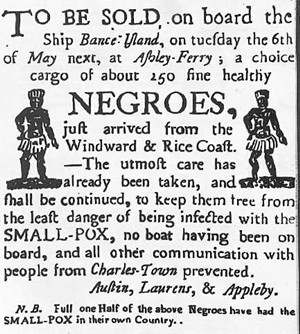
A newspaper advertisement from 1760, for the sale
of slaves, at Ashley Ferry outside of Charleston, South Carolina. Published: The Charleston Gazette, April 26, 1760 35
|
This
Article is Copyright ©2020 by Rick Bushong and
Commercial Use is Prohibited.
Non-commercial use is
permitted if copyright information is
included.

|
References for Epilogue:
- "Journey to Pennsylvania in the Year 1750 and Return to Germany in the Year 1754" By: Gottlieb Mittelberger, Published 1756
- The John Naas Letter, of the Crossing on the "Pennsylvania Merchant" 1733
- The
Keck House
- Transcriber's Guild, Pink "John and William" Passenger List
- Direct
Search the Bushong United Family Tree
database.
- Magdalena Emich
- Vosselmann baby, Eva Elizabeth
- Notes and Queries: Historical, Biographical and Genealogical,
edited by William Henry Egle, Published 1898 Page 200
- Murder Lurks on the Pink "John and William"
- The Pennsylvania Gazette, March 8, 1733, Page 2
- FamilySearch.org Casper Williser
- The Pennsylvania Gazette, April 5, 1733, John & William, Constable Tymperton, to Lisbon.
Page 2
- Colonial America in the Eighteenth Century, by James T. Lemon,
Page 13
- Exposition on the Common Prayer, February 22 1737, No.XXXII
- Wikipedia: The Spa, Scarborough
- Wikipedia: Will's Coffee House
- Wikipedia: Coffeehouses
- Turkish Coffee World History of Coffee
- Exposition on the Common Prayer, January 11, 1737, Number XXVI
- Guildhall Library Manuscripts: index to
St Katharine by the Tower marriage licence records
Tower
marriage licence records
- Notes and Queries for Readers and Writers, Collectors, Volume 9 Page 109
- Glasgow Courant, March 7-14, 1748
- Aspects of Capital Investment in Great
Britain 1750-1850: A Preliminary Survey, By S.
Pollard, J.P.P Higgins, Published 1971, page 155 and 156
- The Universal British Directory of Trade, Commerce,, Volume 4
By Peter Barfoot, John Wilkes, Page
748
- Wikipedia: Cape Fear (area)
- The Royal Colony of North Carolina, King George's War of 1744-1748
- A Maritime History and Survey of the Cape Fear and Northeast Cape Fear Rivers, Wilmington Harbor, North Carolina, By Claude V. Jackson, 1996, Volume 1
- Learn
North Carolina
- BBC - Legacies - Immigration and Emigration - England - Bristol - Legacies of the Slave Trade Page 2
- BBC - Legacies - Immigration and Emigration - England - Bristol - Legacies of the Slave Trade Page 1
- Port Cities of Bristol
- North Carolina Office of Archives and History
The Town of Brunswick
- Slavery in North Carolina
- The Abolition of the Slave Trade slave imports
- Published: The Charleston Gazette, April 26, 1760
- Notes and Queries, July - December 1856
Page 273
- The Ephemera Society Scarborough Spaw
- A Journey from London to Scarborough, in Several Letters from a Gentleman: page 40
- FamilySearch.org
- Historic Homes and Institutions, page 34
Further Reading On Bushong United:
Further Reading:
- Anecdotae Eboracenses: Yorkshire anecdotes; or remarkable incidents in the ...
By Richard Vickerman Taylor. Published 1887 Page 81
- Greater Than the Mountains Was He: The True Story of Johann Jacob Shook of Haywood County, North Carolina.
By Wilma Hicks Simpson Published 2013 click here
- Pennsylvania Germans, A Persistent Minority. William T. Parsons. Collegeville, PA: Chestnut Books, 1985,
- The German immigration into Pennsylvania through the
port of Philadelphia from 1700 to 1775 part II: The
Redemptioners, by Frank Ried Diffenderffer, Published
1900
click here
- The English Spa, 1560-1815: A Social History, By Phyllis May Hembry, Published 1990 click here
|
|



